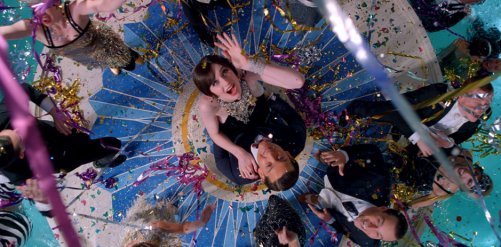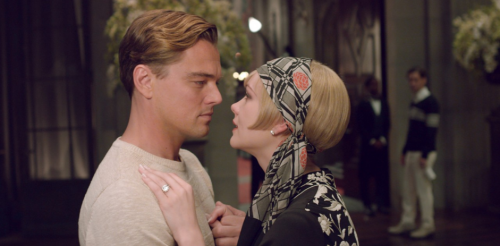TW Review by John Michael Bell
Why Baz Luhrmann’s Gatsby Is Too Faithful to the Book
There’s a famous passage in The Great Gatsby that I’ve long loved. It comes at the end of chapter six, during a brief flashback in which Gatsby kisses Daisy for the first time:
His heart beat faster and faster as Daisy’s white face came up to his own. He knew that when he kissed this girl, and forever wed his unutterable visions to her perishable breath, his mind would never romp again like the mind of God. So he waited, listening for a moment longer to the tuning-fork that had been struck upon a star. Then he kissed her. At his lips’ touch she blossomed for him like a flower and the incarnation was complete.
That is just some damn beautiful prose. Whenever I read the book—four times now—I look forward to that passage. I treasure things that strive simply to be beautiful. And as I watched Baz Luhrmann’s new film adaptation of F. Scott Fitzgerald’s novel, I waited and hoped, wondering how the controversial director would handle this scene.
Would it have the musical-romance-on-steroids feel of Moulin Rouge!, his 2001 film? Would it have the delicacy of the romantic tango scene in his 1992 Strictly Ballroom, in which two characters wordlessly fall in love while dancing to “Perhaps, Perhaps, Perhaps”?
I enjoy the way Lurhmann pumps up anything he gets his hands on. I’m always drawn to his visual style. Whether that Gatsby scene failed or succeeded, I expected it to have his distinctive stamp. At the very least, I assumed it would be interesting.
Instead, the scene plays out with the flashback intercut with Gatsby (Leonardo DiCaprio) reciting the first part of the passage verbatim before the book’s narrator, Nick Carraway (Tobey Maguire), finishes it by literally typing the words onto the screen.
My heart sank. Fitzgerald’s words sing because of the images they conjure in the reader’s imagination. I wanted Luhrmann’s vision of this scene, the one that played in his head when he read the book—not an absurdly literal depiction of the passage.
Unfortunately, much of this long-awaited and much-hyped film imitates rather than adapts the book. In its strict adherence to Fitzgerald’s words, it fails to evoke what makes those words so effective. Luhrmann, the master of strobe light color and pounding soundtracks, blows it in the most ironic way: His Gatsby lacks the book’s electricity.
If only Luhrmann had cut down the constant narration, allowing the scenes to breathe on their own. But his film keeps telling, telling, constantly telling, never mind that we can see perfectly well what’s going on.
When Tom Buchanan (Joel Edgerton) panics about the women is his life—Daisy leaving him for Gatsby, Myrtle being forced to move by George—Nick’s voiceover is there to tell us just how panicked he is and why. When Daisy (Carey Mulligan) cries into a pile of Gatsby’s shirts (“They’re such beautiful shirts!”), Nick tells us that Daisy might very well be crying about something other than Gatsby’s wardrobe. You don’t say.
The fact that the narration comes from the book is not a defense. In the book, Nick’s narration is necessary, because the words are all we have to convey images. But a movie is supposed to do a lot of visual heavy lifting for us.
Narration can be useful in a film when it doesn’t overplay its hand. In The Shawshank Redemption, Morgan Freeman’s character Red provides an almost constant running commentary on the events of the film. However, his narration conveys Red’s interpretation of those events, adding to what we see on the screen.
Luhrmann’s The Great Gatsby ends up being a lushly shot series of familiar events, playing out with varying degrees of energy. His deviations from the novel are largely superficial, such as the cacophonous party scenes and the use of hip-hop and rock in the soundtrack. These are the scenes that work. They’re rowdy and entertaining. They’re also window dressing, brief interludes of style in an adaptation that is otherwise very loyal to the novel.
The film is uneven not because Luhrmann’s style is wrong for Fitzgerald, but because Luhrmann, rather than finding a movie within the pages of The Great Gatsby, instead copied and pasted the book wholesale onto the screen and tried to make it look like his own on the periphery.
Luhrmann’s 1996 film Romeo + Juliet is far more successful because it strikes a balance between faithfulness of adaptation and freshness of directorial vision. It does not alter the Bard’s dialogue. The tone and energy of the film are cranked high, of course, but it’s an exhilarating high. Luhrmann took Shakespeare’s words and made them work at his volume. He looked for a Baz Luhrmann film in Romeo and Juliet, and, by God, he found it.
The Great Gatsby is not a total failure. Everything looks fantastic. Leonardo DiCaprio, Carey Mulligan, and a scene-stealing Elizabeth Dibicki as Jordan Baker are all good. No working actor fits the classic movie star mold quite like DiCaprio. His performances, like Luhrmann’s films, are consistently heightened and stylized, and that works well here. Carey Mulligan is well cast as Daisy. She doesn’t let us forget how vicious it is for Gatsby and Tom to play tug-of-war with the history of her affections.
The film’s problem is not the cinematic components but how the story, this story, plays on the screen. I wish Luhrmann had taken the passage I love so much and filmed it entirely without talk. Fitzgerald wrote a beautiful scene there, but in this film, it’s reduced to words on a page.
 John Michael Bell is a social media intern for Talking Writing and a freelance writer in New Bedford, Massachusetts. He recently graduated from the Harvard Extension Journalism program. His love of pop culture, along with trying to make sense of it through writing, often drives him to the brink of insanity, which he resolves by making a pilgrimage to the Brattle Theater in Harvard Square.
John Michael Bell is a social media intern for Talking Writing and a freelance writer in New Bedford, Massachusetts. He recently graduated from the Harvard Extension Journalism program. His love of pop culture, along with trying to make sense of it through writing, often drives him to the brink of insanity, which he resolves by making a pilgrimage to the Brattle Theater in Harvard Square.
You can see more of his writing at his film and television blog The Sixth Station.


